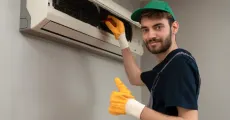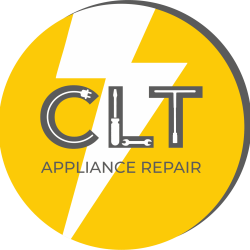Fixes for Drainage Problems in | Air Conditioners

Air conditioner drainage problems, such as clogged lines and leaks, can lead to reduced efficiency and water damage. This guide offers practical fixes to common AC drainage issues, tips for preventing future problems, and advice on when to call a professional.
Fixes for Drainage Problems in Air Conditioners
Your air conditioner’s drainage system is essential for removing excess moisture during operation. When this system fails, it can cause water leaks, clogs, and even damage to your home. Here’s how to identify and fix these issues to keep your AC running efficiently.
Your fridge is a kitchen superstar as it keeps all your food fresh and drinks cold.
But does the fridge feel warm when you open it?
Is there water all over the floor?
Fridge issues are the worst!
Signs of AC Drainage Issues
- Water pooling near the unit: Indicates a clogged drain line.
- Musty odors: Mold growth in a blocked drain line.
- Frequent system shutdowns: Triggered by a full or leaking drain pan.
- Reduced cooling performance: Excess moisture can hinder AC efficiency.
Common Causes of Drainage Problems
- Clogged Drain Line: Dirt, algae, and debris can block the drain pipe, preventing proper water flow.
- Damaged Drain Pan: Cracks or rust in the pan can cause leaks.
- Improper Installation: A poorly installed unit may not have proper drainage angles.
- Low Refrigerant Levels: This can cause coils to freeze and result in excess water when thawed.
Step-by-Step Fixes for AC Drainage Problems
Unclogging the Drain Line
- Turn off the AC: Switch off the unit at the thermostat and breaker.
- Locate the drain line: Usually found near the indoor unit, it leads to the outside.
- Clear the clog: Use a wet/dry vacuum to suction out debris. Alternatively, flush the line with a mix of warm water and vinegar.
- Check for blockages: Inspect the drain exit to ensure water flows freely.
Repairing or Replacing the Drain Pan
- Inspect the pan: Look for cracks, rust, or damage.
- Patch minor cracks: Use a waterproof sealant to fix small leaks.
- Replace the pan: For extensive damage, install a new drain pan compatible with your system.
Adjusting Installation Errors
- Check the unit’s level: The AC should tilt slightly toward the drain line.
- Reposition the unit: Adjust the leveling to ensure proper drainage.
Preventing Frozen Coils
- Inspect refrigerant levels: Low levels can cause coil freezing, leading to excess water when thawed.
- Replace dirty filters: Clogged filters restrict airflow, causing ice buildup.
Preventing Future Drainage Problems
- Clean the drain line regularly: Flush it with vinegar every 3–6 months to prevent blockages.
- Change air filters frequently: This reduces dirt accumulation that could block the drain.
- Schedule regular maintenance: Professional tune-ups catch issues early.
- Install a float switch: This safety device shuts off the AC if the drain pan overflows.




Get Your AC Drainage Issues Resolved Today!
Experiencing a sudden leak? We provide prompt, same-day service to keep your home comfortable. Contact CLT Appliance Repair for expert air conditioner repair charlotte nc and maintenance. We offer cost-effective fixes for clogged drain lines, leaky pans, and other drainage issues.
With our fast and reliable service, you can enjoy a cooler, worry-free home!
Don't let a malfunctioning Air conditioner disrupt your daily life. Contact CLT Appliance Repair today at 704-606-9043 to schedule your Air conditioner repair service.
We'll have your fridge back to optimal performance in no time!
- Air Conditioner Not Cooling
- Air Conditioner Leaking Water
- Air Conditioner Making Noise
- Air Conditioner Not Turning On
- Air Conditioner Frozen
- Air Conditioner Sensor Issues
- Air Conditioner Electrical Issues
- Air Conditioner Compressor Problems
- Air Conditioner Thermostat Issues
- Tips for maintaining an air conditioner.
FAQs
A clogged drain line or a full drain pan is often the cause. Address the issue quickly to avoid water damage.
While bleach can work, vinegar is safer and less corrosive for your system.
Clean it every 3–6 months or during your regular AC maintenance schedule.
Ignoring the issue can lead to mold growth, water damage, and decreased AC efficiency.
Yes, unresolved drainage issues can make your AC work harder to cool, leading to higher energy consumption and increased utility bills.
Appliance Repair Indian Land SC | Appliance Repair Indian Trail NC | Appliance Repair Pineville NC | Appliance Repair Rock Hill SC | Appliance Repair Belmont NC | Appliance Repair Matthews NC | Appliance Repair Lancaster SC | Appliance Repair Cornelius NC | Appliance Repair Fort Mill SC | Appliance Repair Concord NC | Appliance Repair Denver NC | Appliance Repair Monroe NC | Appliance Repair Mooresville NC | Appliance Repair Harrisburg NC | Appliance Repair Lake Wylie SC | Appliance Repair Huntersville NC | Appliance Repair Kannapolis NC | Appliance Repair Mint Hill NC | Appliance Repair Waxhaw NC | Appliance Repair Troutman NC | Appliance Repair Davidson NC | Appliance Repair Gastonia NC | Appliance Repair Charlotte NC

